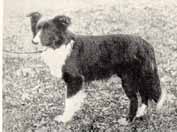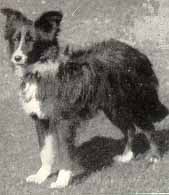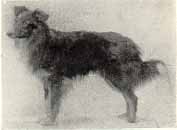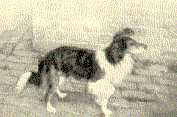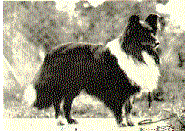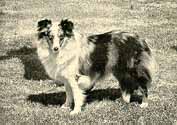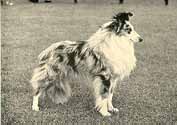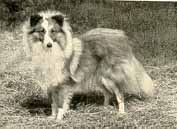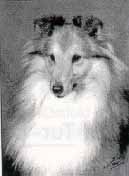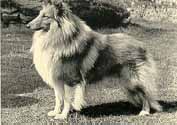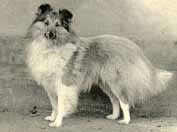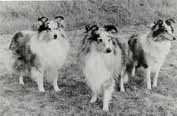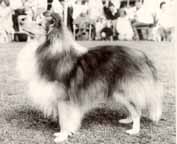Those of us who are keen readers of as many books on The Shetland Sheepdog as we can lay our hands on, must be aware of how the Sheltie has changed since it was the little dog, working in all weathers on the Islands to look after the sheep belonging to his Master and the Family. The climate of the Islands was cold and bleak in the long Scottish winters, so this dog although small, was strong because he had to withstand all extremes of weather and intelligent because of the work he must do. The early pictures show us a small, fairly long haired dog, with an almost Border Collie type head and some have been described as 'pommie' because of their rounded skulls, deep stop and short muzzles. It is not really known exactly when the Sheltie has it origins, but in the very early 1800's they were thought to be a type of small working Collie which had been crossed (mostly by accident!) with the Icelandic Dog bought from Iceland on the fishing boats visiting the Shetland Islands. It has also been suggested that there may be some crossing with the Cavalier King Charles spaniel, but most of this information is sketchy and not actually proven. What is known however, is that a Mr. J Loggie who was one of the first Sheltie enthusiasts from the islands took the rather courageous step of introducing a small show Collie into the breed. This he did to establish a definite type, up until that time the little dog tended to appear as a variety of types, sometimes with a head which resembled a spitz type of dog, with pricked ears, or sometimes with a head of more rounded appearance, with a round eye to match! Apparently the actions of Mr. Loggie caused some concern amongst the Sheltie fanciers of that time, but it has since been acknowledged that it was probably one of the best things to happen
Little was known on Mainland Britain of the Shetland Sheepdog until 1906 when the first Shelties were shown at Cruft's Dog show. Two years after that the Shetland Collie Club was founded in Lerwick, the capital of the Shetland Islands, then in 1909 the Club asked the Kennel Club for permission to change the name of the breed to Shetland Sheepdog, but this was refused. The breed was at this time, rather smaller than the present day - in 1909 the standard described them as "a Collie in miniature, height to be about 12 inches" and at this time there were two varieties, rough and smooth.
By 1909, the breed was becoming fairly popular both as a pet and a showdog and several societies were scheduling classes on the Mainland, although people were quite confused about the different types still to be seen in the ring.
1914 was a turning point for the breed with the formation of the English Shetland Sheepdog Club in January, then in August of the same year the Kennel Club gave the breed it's official recognition as a separate breed and gave it the name Shetland Sheepdog. The following year Challenge Certificates were offered and a year later the first breed champion emerged - Ch. Woodvold. Due to the World War which was raging during these important first years, little breeding and showing was done and by 1917 the breed was facing almost extinction. Miss Humphries of the Mountfort prefix, decided that it was time for another Collie cross as type seemed to be varied again, so the introduction of a small Collie bitch, Teena who was mated to a dog called Wallace seemed to set the foundations for the type which we know today. Miss Humphries made no secret of her Collie cross and most breeders accepted that in order to establish a definite type, this was necessary.
1924 saw the last of the necessary Collie crosses, this time a bitch, Chestnut Sweet Lady was mated to Chestnut Rainbow, a tricolour Sheltie and the result was eight puppies. This was to be one of the most important litters in the breeds modern day history, as one of the puppies, Chestnut Bud was sold to Jim Saunders of the Helensdale prefix and Bud was behind many of the famous Helensdales. Four puppies were sold to Dr. Margaret Todd of the Clerwood prefix, and the smallest puppy was bought by Mrs. E. Baker of the Houghton Hill prefix. This dog was the sire of Ch. Uam Var of Houghton Hill, one of the most important sires in those years leading up to the Second World War. Mrs. Sangster of the Exford prefix was the daughter of Mrs. Baker, so the Exfords had the good foundation of the Houghton Hills on which to build. The Exfords and a few years later, the Riverhills, were already established before the war, but were to become probably the most well known kennels of the post war years.
The entries of Shelties at shows during the late forties and fifties steadily increased, with more and more people finding the charms of the Sheltie hard to resist. Pictures of the Riverhills of this period show us the wonderfully balanced heads with flat skulls together the correct shape and placement of the eyes which makes the expression that is exclusive to the Sheltie. The Misses Rogers were very keen horsewomen and so construction and movement was a very important item on their breeding agenda as they knew the pitfalls of breeding animals with bad construction. The Exford Shelties were also very famous for their excellent construction and movement. They lived in the New Forest - a large area of natural forest in the South of England. They had the total freedom of the forest and used to accompany Mrs. Sangster when she rode her horses out on their daily exercise, so the Exfords had to be able to keep up with a galloping horse for many miles.The fifties and early sixties saw a huge increase in the popularity of the breed, not always a good thing because there is a danger of any breed becoming commercialised. The influence of the pre war kennels was, by this time, very important and the newer breeders who were keen to learn tended to attach themselves to the experienced people.
In the show ring during this period of time, very little importance was paid to temperament - the breed standard stated that the dog should be "reserved towards strangers" and I think this was taken literally. I can remember going to shows in the early sixties and watching some of these really beautiful dogs standing behind their owners legs while they were being judged, with the owners hardly noticing. Most of the championship show judges were breed specialists and were used to this kind of behaviour so paid very little attention.
The dog that turned this situation around (in my opinion) was Ch. Antoc Sealodge Spotlight. A most beautiful Sheltie to look at in profile, he had a lovely shape with a super neck and topline, well-balanced head with the neatest of ears which he never stopped using. He hadn't got the best front angulation in the world, but he was of outstanding quality and correct breed type. He was also a magnificent showman, totally in tune with his handler, and it was very obvious that he really enjoyed being a show off!! He took the eye of several all breeds judges, which previously a Sheltie had been unable to do (with the exception of Ch. Helensdale Ace). This then made the newer breeders sit up and take notice, realising that not only did they have to aim to produce Shelties of the right size, with correct heads and construction but they must also do something to improve the temperament.
It was quite an uphill struggle. So many of the larger kennels kept Shelties in vast numbers which meant they were unable to give the dogs the individual attention that they required to improve their temperaments. As the larger kennels also had the stud dogs which were influencing the breed at that time, it was difficult to plan a breeding programme when type, quality and now temperament was the consideration. Sadly Spotlight who was mainly Riverhill bred, was discovered to be infertile after siring just a few litters - his breeding and outstanding temperament would have been invaluable to many people, but it was not to be.
By the end of the sixties, Shelties were being bred by people who kept just a few dogs in the house, which meant that the dogs were very much part of the family, mixed with the children, saw all the visitors and were beginning to become much more sociable. However, with the increase in the number of Shelties being bred and shown, came a decline in the quality of the puppies being produced. People were taking less notice of the advice of the experienced breeders and were producing Shelties without thinking of the future generations. Temperament of course, was improving, but bad faults were creeping in, like straight shoulders and upper arms, also Shelties which were well over the size limit. Breeders were breeding from bitches of inferior quality and mating them to stud dogs who were popular and winning well at the time, without thinking whether or not the pedigrees of each were compatible.
Then came CEA!! Up until this time the only eye disease we had heard of was PRA and this didn't really affect the Sheltie. Then Dr. Keith Barnett who was the leading authority on animal eyes in this country visited America and came back with the disturbing news of this new disease which had been discovered in Shelties there. Everyone breeding Shelties was encouraged to have all their dogs tested. Some did and some decided it was best not to know, so without making testing compulsory it was very difficult to establish any kind of pattern of how the disease was, or was not progressing in the U.K. Most of the newer breeders tested, but the pre war people decided that it was best to leave well alone.By the mid seventies, more testing was being done and a pattern of affected lines was emerging, which meant some of the top stud dogs were no longer being used by so many people. This led to quite a variation in type and quality again, as breeders were tending to use clear dogs irrespective of their pedigree or suitability. Of course, much discussion followed on this subject, whether or not we should concentrate mainly on eradicating CEA or push CEA to the side and breed for the correct type.
During the eighties, the breed lost the influence of some of the top kennels, Riverhill, Shelert and Exford being the main ones. With their demise the breed had not only lost some outstanding Shelties, but the knowledge and experience of their breeders went with them. It is a well known fact that with age and experience comes wisdom and knowledge, so the breed had then to rely on those who had taken the trouble to learn and benefit from the teachings of these knowledgeable people.
Some new names have emerged in the late eighties and nineties, some have fallen by the wayside, others have proved to be beneficial to the breed by breeding for correct type and quality. Sadly type is still varied, but this is bound to happen when so many people are breeding, and do not have the experience to know exactly what is meant by the correct type. It is the responsibility of every breeder and judge to concentrate on this true Sheltie type and as we go into the next century we can only hope that everyone understands the importance of doing this, thus keeping the Sheltie as our standard describes it "a small long haired working dog of great beauty"
It is true to say that over the years there have been changes in the appearance of the Sheltie, but the last forty years have seen the improvement of the temperament which has to be an asset. We now have to safeguard the breed and not allow it to become a tool for ambitious people who are looking for a quick way to the top and who care nothing for the well being and future preservation of the correct type.
Last updated: 30/7/20
Lerwick Olaf
Lerwick Jarl
Ch Woodwold
(The first champion in the breed)
Ch Specs of Mountford
Wallace
(foundation dog
of the male line BB)
Chestnut Rainbow
Ch Uam Var of Houghton Hill
Ch Blue Charm of Exford
Ch Riverhill Rogue
Ch Helensdale Ace
Ch Antoc Sealodge Spotlight
Ch Midas of Shelert
Ch Riverhill Rare Gold
Ch Such A Spree at Shelert, Ch Such a Frolic At Shelert and
Ch She's My Fancy at Shelert
Ch Jefsfire Freelancer
Ch Midnitesun Justin Time
